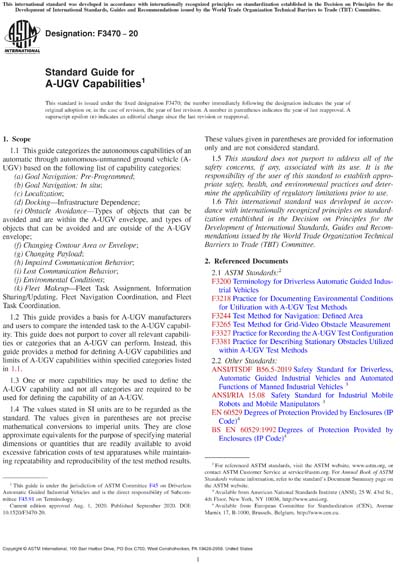Most recent
ASTM F3470-20
Standard Guide for A-UGV Capabilities
1.1 This guide categorizes the autonomous capabilities of an automatic through autonomous-unmanned ground vehicle (A-UGV) based on the following list of capability categories:
(a) Goal Navigation: Pre-Programmed;
(b) Goal Navigation: In situ;
(c) Localization;
(d) Docking—Infrastructure Dependence;
(e) Obstacle Avoidance—Types of objects that can be avoided and are within the A-UGV envelope, and types of objects that can be avoided and are outside of the A-UGV envelope;
(f) Changing Contour Area or Envelope;
(g) Changing Payload;
(h) Impaired Communication Behavior;
(i) Lost Communication Behavior;
(j) Environmental Conditions;
(k) Fleet Makeup—Fleet Task Assignment, Information Sharing/Updating, Fleet Navigation Coordination, and Fleet Task Coordination.
1.2 This guide provides a basis for A-UGV manufacturers and users to compare the intended task to the A-UGV capability. This guide does not purport to cover all relevant capabilities or categories that an A-UGV can perform. Instead, this guide provides a method for defining A-UGV capabilities and limits of A-UGV capabilities within specified categories listed in 1.1.
1.3 One or more capabilities may be used to define the A-UGV capability and not all categories are required to be used for defining the capability of an A-UGV.
1.4 The values stated in SI units are to be regarded as the standard. The values given in parentheses are not precise mathematical conversions to imperial units. They are close approximate equivalents for the purpose of specifying material dimensions or quantities that are readily available to avoid excessive fabrication costs of test apparatuses while maintaining repeatability and reproducibility of the test method results. These values given in parentheses are provided for information only and are not considered standard.
1.5 This standard does not purport to address all of the safety concerns, if any, associated with its use. It is the responsibility of the user of this standard to establish appropriate safety, health, and environmental practices and determine the applicability of regulatory limitations prior to use.
1.6 This international standard was developed in accordance with internationally recognized principles on standardization established in the Decision on Principles for the Development of International Standards, Guides and Recommendations issued by the World Trade Organization Technical Barriers to Trade (TBT) Committee.
Content Provider
ASTM International [astm]






